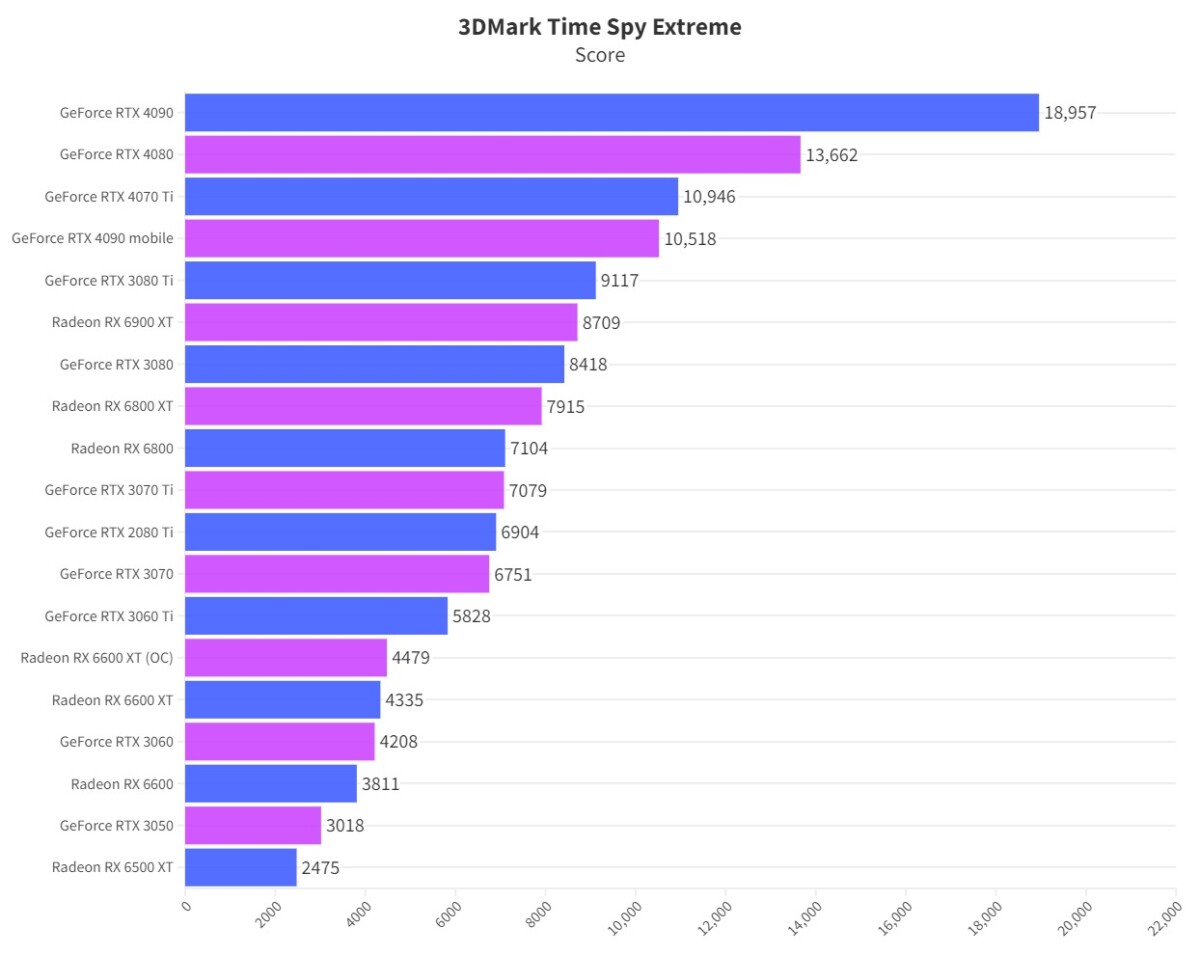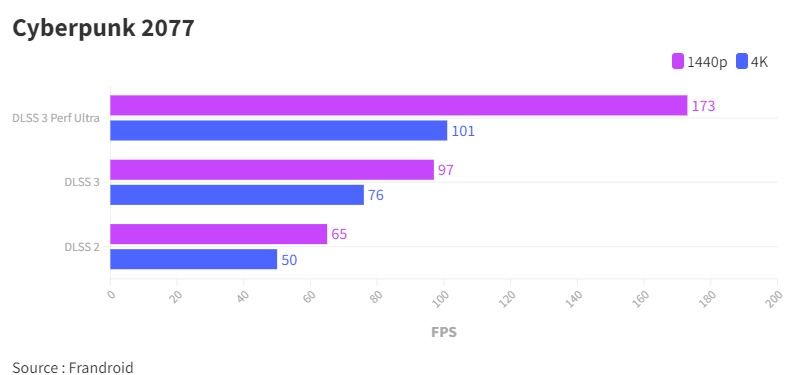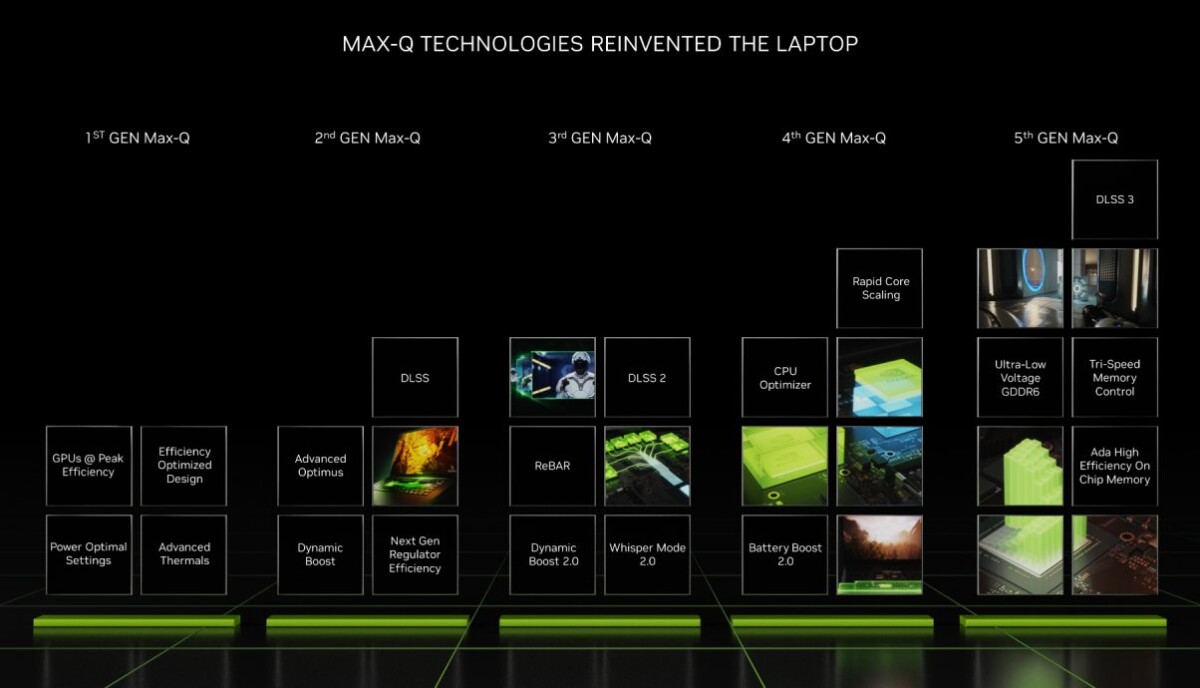We had the opportunity to test the GeForce RTX 4090 mobile, the most powerful graphics card currently available for laptops. Benchmarks, DLSS 3… here’s our complete review.
Following the desktop versions of its Ada Lovelace architecture-based graphics cards, Nvidia announced the mobile versions of its RTX 40xx series at CES 2023. In total, five GPUs were announced, offering more power and new technologies such as the introduction of the 5th generation Max-Q.
We tested the GeForce RTX 4090 mobile to get an idea of its capabilities.
Technical Specifications of the GeForce RTX 4090 Mobile
The Nvidia GeForce RTX 4090 mobile is the most powerful graphics card currently available for laptops.
| Property | Specification |
|---|---|
| Model | GeForce RTX 4090 Mobile |
| Architecture | Ada Lovelace |
| CUDA Cores | 9728 |
| Tensor Cores | 304 |
| RT Cores | 76 |
| Clock Frequency | 1455 – 2040 MHz |
| TGP | 80 – 150 W (+25 W) |
| Memory | 16 GB GDDR6 |
| Memory Bandwidth | 256-bit |
This GPU has more than 1300 additional compute units compared to the RTX 3080 Ti mobile (7424) and its TGP goes up to 175 W with Dynamic Boost 2.0.
Our Configuration: Razer Blade 16
To test the performance of this RTX 4090 mobile and see what the additional cores bring, Nvidia provided us with a Razer Blade 16 (2023). In addition to its brand new GPU, it is equipped with an Intel Core i9-13950HX processor with 24 cores and 32 threads and a base frequency of 2.2 GHz (5.5 GHz in turbo), 32 GB of DDR5 RAM (2x 16 GB @ 4800 MHz), and 1 TB of NVMe SSD storage.
Finally, it powers a 16-inch UHD+ (3840 x 2400 pixels) 120 Hz display. For this test, unless otherwise stated, the results were obtained with the screen resolution set to 2560 x 1600 pixels to match the most common use. This resolution should be more common on laptops in 2023.
Our tests were carried out on Windows 11 (Home 22H2) with Nvidia drivers version 528.37.
RTX 4090 Mobile Benchmarks
RTX 4090 Mobile on 3DMark
To measure and compare the raw graphics power of a GPU (without the use of AI, for example), the synthetic benchmark 3DMark Time Spy Extreme is an obvious reference.
On this test, which generates a 4K render (under DirectX 12), we achieved a graphics score of 10,518, with an average of 67.78 frames per second on the first part and 60.91 FPS on the second part. We note that despite the heat — up to 80° during our third consecutive run — the scores never waver. This result is slightly below the desktop RTX 4070 Ti (10,946) but significantly above the RTX 3080 Ti mobile (6,513).

Let’s remember that this test is purely synthetic, without ray tracing or DLSS.
In ray-tracing
In February 2022, we reported that the RTX 3080 Ti mobile was very impressive on the 3DMark DirectX Raytracing test with a measurement of 36.94 frames per second, “simply one of the best results we have recorded on this test.” One year later, the RTX 4090 mobile can display an average of 68.70 FPS on the same test and maintain this score over time.
For comparison, the desktop RTX 4070 Ti has an average of 66.44 FPS on the same test. The Ada Lovelace architecture demonstrates its undeniable superiority over previous generations that could not exceed 60 frames per second.
The RTX 4090 mobile on V-Ray and OctaneBench
The architecture performs well in gaming and professional applications. We wanted to measure this with V-Ray and OctaneBench, benchmarks evaluating the 3D modeling part.
In this test, our machine scored 747 on OctaneBench with ray tracing enabled and 525 without RT. On V-Ray, it reached 2550 on its CUDA cores and up to 3460 with ray tracing.
Even for professionals, the RTX 4090 mobile is currently the best choice for a laptop to improve efficiency.
Cyberpunk 2077
To thoroughly test the capabilities of the RTX 4090 mobile, our first test focused on Cyberpunk 2077, a recent resource-intensive game compatible with DLSS 3.
On the game’s built-in benchmark, with Ultra settings, we reached an average of 97 frames per second with DLSS 3 in auto mode (59 ms latency). With DLSS 2, the game runs at 65 FPS on average, with a latency of 45 ms. If we switch to 4K (3840 x 2400 pixels), the benchmark still ends with an average of 76 FPS with DLSS 3 (51 ms latency), which is already a lot for this game and resolution.
By setting DLSS to “Ultra Performance” mode with image generation (DLSS 3), we reached 96 FPS in 4K with 61 ms latency. Again, these are the performances obtained with a desktop RTX 4070 Ti. It’s quite an achievement for a laptop.

With DLSS 3 in 4K, we get performances roughly equivalent to what the 3080 Ti mobile offered… in Full HD.
Spider-Man Miles Morales
We returned to 1600p to test DLSS 3 on Spider-Man Miles Morales, a fast-paced game where the display changes quickly.
On the Marvel game, we recorded an average of 85 FPS with DLSS 2 and 40 ms latency, versus 115 FPS and 70 ms latency with DLSS 3. The framerate gain is significant, while the latency difference is barely noticeable when playing. This is because the difference in display lag represents less than one frame between pressing a button and the action appearing on screen.
A Plague Tale: Requiem
To provide a slightly less flattering example for this GPU, let’s look at A Plague Tale: Requiem, also compatible with DLSS 3, still in 1600p and with Ultra settings.
In terms of average performance, the game performs very well, with a magnitude similar or even superior to the desktop RTX 4070 Ti. Depending on the options selected, the game runs around 175 FPS (DLSS 3 Auto) or even 216 FPS (DLSS 3 Ultra Performance). Here too, the small increase in measured latency does not disrupt the solo game progression.

The game highlights the limitations of gaming on a laptop. While the results are very good, even excellent, they are slightly marred by the “1% low” – the average of the lowest 1% of FPS. While the desktop RTX 4070 Ti boasts a solid 121 FPS for smooth gameplay, the “1% low” here fluctuates between 50 and 67 FPS.
This difference between the average and the 1% low can sometimes result in noticeable latency during gameplay, especially during long sessions when the laptop heats up.
5th Generation Max-Q Technologies
One of the main advantages of Nvidia cards lies not only in the power of the GPUs but also in the entire application ecosystem developed over generations. These technologies, which Nvidia integrates under the name Max-Q, are now in their 5th generation. Some allow for significant performance gains, while others are harder to measure.
DLSS 3
The first, which we have mentioned throughout this article, is Nvidia’s flagship technology: DLSS. This supersampling technology is now in its third generation, allowing not only to extrapolate pixels by creating a low-definition render scaled by Tensor cores but also to generate images.
These additional images provide a definite framerate boost and thus a sense of fluidity but come with two trade-offs. The first is increased latency, and the second is that these additional images can only anticipate the movement of what is already on screen. You will not see your enemies emerge from behind a wall earlier despite your additional images.

These trade-offs are entirely acceptable in single-player games and provide a highly enjoyable experience. In multiplayer games, it’s up to each player’s preference. If you’re not playing competitively, it’s possible, but if you want to optimize your performance and your configuration allows it (presumably with an RTX 4090 mobile), don’t hesitate to stick with DLSS 2.
Dynamic Boost 2.0 (Max-Q 3rd gen)
This technology allows your PC manufacturer to allocate more power to your GPU if your CPU does not need it. In games with high graphical resource demands and low computational power requirements, you can gain up to 25W of GPU power. This boost is dynamically retrieved from your CPU and reallocated when needed.
Power Consumption Management
This fifth generation focuses more on power consumption than performance (already significantly improved by DLSS 3). Nvidia announces high-efficiency memory, low-voltage graphics memory, and three-speed memory control to consume less when power is not needed.
In practice, this is not directly noticeable in consumption. During our tests, the GPU consumed 7 to 10W on an idle desktop and around 110W in-game. So, the consumption remains roughly the same as the previous generation, but with a significant performance gain.
A Mobile GPU Designed for 4K
The RTX 40xx mobile series is expected to be equivalent to the desktop series in terms of intergenerational evolution. The gain is significant, especially in games compatible with DLSS 3. However, such games are still limited (around fifty, counting upcoming ones).
The RTX 4090 mobile specifically targets the most demanding users, as you won’t find anything better in a laptop currently. When present, DLSS 3 allows for seamless 1440p or even 4K gaming with performance equivalent to what the previous generation offered in Full HD, without increased consumption. The performance-per-watt ratio is certainly there.
Of course, excellence comes at a price. In this configuration, the Razer Blade 16 costs $5,400. At this price, it’s hard to recommend to the average user until more DLSS 3-compatible games are released. We are eager, however, to test the rest of Nvidia’s 40xx mobile series, as the most prominent representative has met our expectations.
The RTX 4090 mobile GPU is clearly designed for 4K gaming and targets the most demanding gamers who seek the best performance in a portable device. Keep in mind that the availability of DLSS 3-compatible games is still limited, which might not justify the high price tag for some users.
If you’re considering investing in a high-end gaming laptop like the Razer Blade 16 with an RTX 4090 mobile, it’s essential to weigh the benefits of the improved performance, power efficiency, and gaming experience against the cost. As more DLSS 3-compatible games are released, the value proposition of such devices may become more attractive to a broader range of users.
In conclusion, the 5th generation Max-Q technologies and the RTX 40xx mobile series demonstrate substantial improvements in performance and power efficiency, particularly when utilizing DLSS 3. For gamers seeking a top-tier mobile gaming experience, these advancements offer significant benefits. However, the high price of these devices may limit their appeal to a niche market until a more extensive range of compatible games becomes available.

